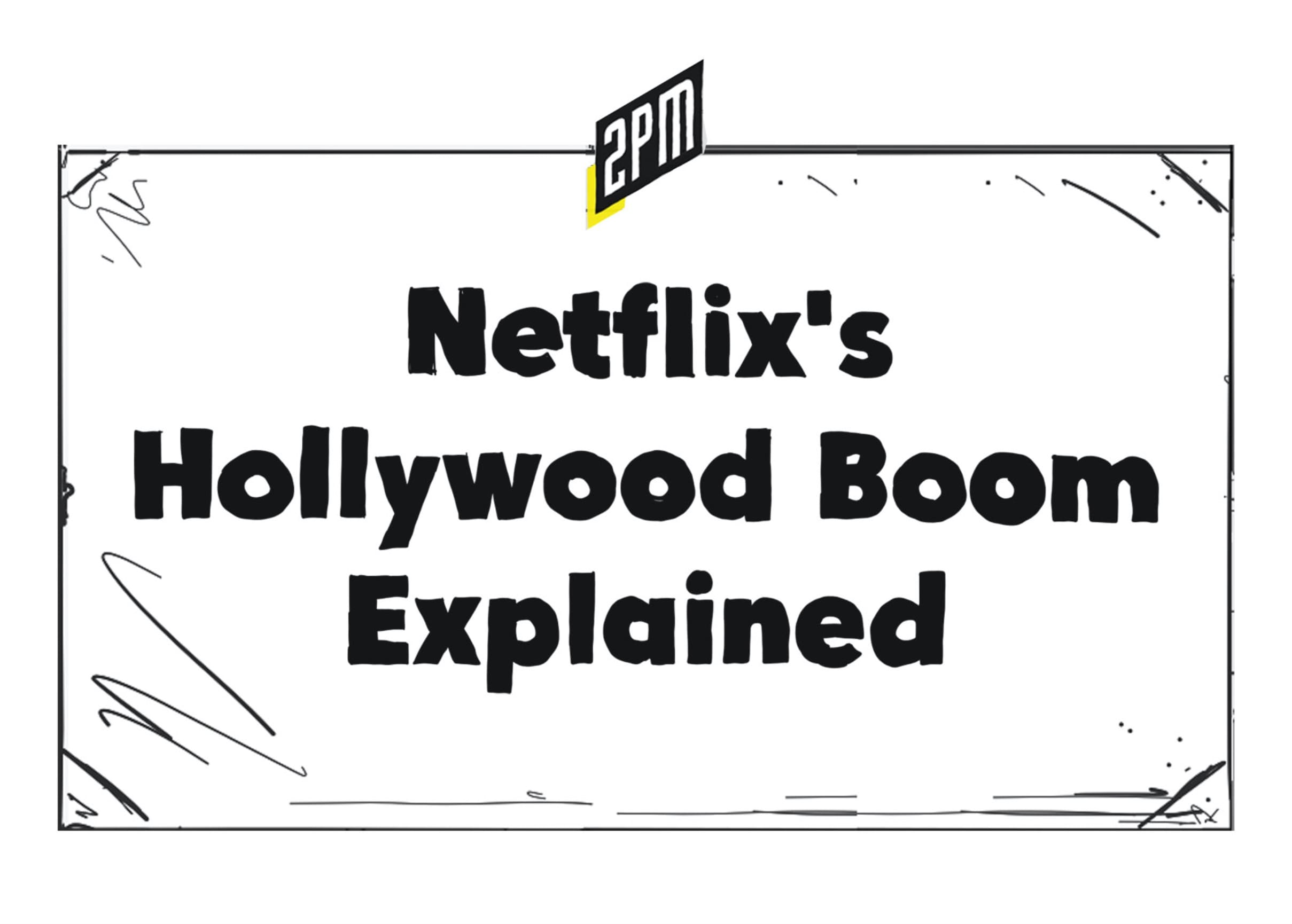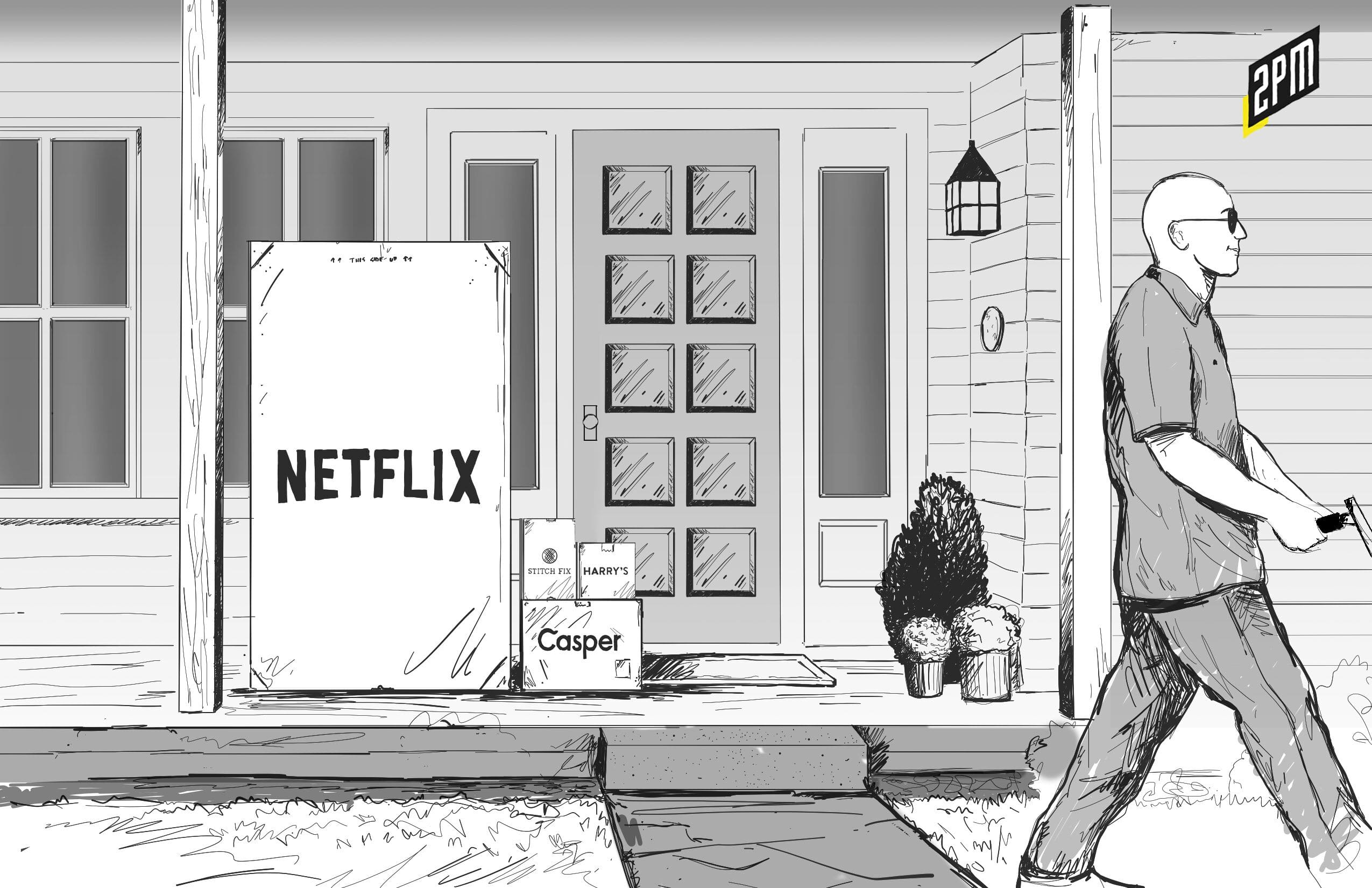
To understand the explosion of the streaming media industry, look at in the context of digital-native brands. To understand the limitations of today’s digital-natives, look at it in the context of streaming media’s growth from fringe idea to Hollywood stalwart.
In 1999, Blockbuster Video was twelve years old with 9,000 stores. Just five years prior, Viacom acquired the company for $8.4 billion dollars. At the time, Netflix was the one-year-old challenger brand. Between the two, we saw the first of its kind. A dynamic between old vs. new and traditional vs. challenger that we would see play out over the next decades between traditional and direct brands.
Timing is everything when an incumbent challenges the titans. On an early January morning in Columbus, Ohio, the former-CFO of Enron Corporation stood before a group of nearly 60 of the city’s entrepreneurs. He narrated the infamous company’s successes, failures, and hidden truths. The Entrepreneur’s Organization commonly hosts keynote speakers but this session was different. We all knew his story. And Andy Fastow was frank in his narration of, he was deeply contrite and his messages illuminated the history in ways that a news broadcast wouldn’t allow – now or then. He walked the audience through the step by step of a company that was unstoppable until it was; he was even more candid in his personal shortcomings. But what you may not have known? Enron played a small role in determining the outcome of today’s streaming wars.
In 2000, Blockbuster Video declined to acquire Netflix for $50 million. Rather, it chose to compete. In doing so, the company agreed to a 20-year deal with that same Enron Corporation to deliver video on demand (VOD) though Enron’s fledgling broadband services division. With this agreement in tact, Blockbuster chose to delay the pivot from bricks and mortar to direct-to-consumer. This was a decision that the company would almost immediately regret.
The Blockbuster executives, who never liked the VOD concept themselves, used the lack of content as their excuse to abandon the partnership with EBS in 2001, saying that they wanted to stay focused on Blockbuster’s bricks-and-mortar stores rather than pursue an online business model. [1]
The difference between success or failure in a category comes down to three variables: (1) timing (2) technology (3) adoption rates. More, in a moment, on the third and final variable. Blockbuster’s timing couldn’t have been worse: Netflix’s DVD business model was catching on and Enron’s team would soon make a decision that would crater an entire company in epic fashion. It was a company that Blockbuster depended on, even if they weren’t in a hurry to do so. It was the typical case of an innovator’s dilemma.
When Enron crashed, Blockbuster’s hopes crashed with it. Their VOD technology was capable but their managers chose not to deploy it, eschewing long-term innovation for short-term profits. Blockbuster was the first-mover in an industry that we didn’t even know we would need. But the company did not want to expand on that early advantage. By the time that Blockbuster’s c-suite identified the need to compete in the VOD (video-on-demand) industry, it was too late. The technologists of the company wanted to pursue a direct strategy, its managers wanted to maintain the company’s emphasis on physical retail.
The DTC Brand Parallel
The direct-to-consumer moniker has been called into question. You’ll find it used in digital media positioning and in retail branding, alike. But what does it mean to be a DTC brand anyway? One private equity investor called the previous month’s retail news “the trinity of doom” for a cohort of DTCs. You know many of them by name. A number of these brands are coveted portfolio companies held by the brightest consumer venture capital firms in Los Angeles, San Francisco, and New York.

Venture firms like Forerunner, Lightspeed, Lerer Hippeau, or agency / venture hybrids like Bullish or Science Inc. have investment theses built on the internet as a primary acquisition tool for these modern brands. But in response to the Bain Capital investor who cited the trinity of doom, the veteran venture capitalist replied: “Harry’s is not a DTC brand. Casper is not a DTC brand.” More on this in a moment.
The conversation between Bain Capital’s Magdalena Kala and Bullish’s Mike Duda caught my attention because it illustrated a growing disconnect in the private market. Private equity is the traditional means of scaling a retail brand that one-day could enter public market. Rightfully, Kala sees things her way. It contends with the current state of the industry. Venture capital is about twelve years into democratization of eCommerce retail, a process that has seen more failure than success. Even so, Mike Duda is as gifted as it gets when it comes to picking early winners. In 2007, dozens of digitally-native brands existed. Today, that number has swelled into the thousands. With the accelerating democratization of DTC, both consumer P/E and venture financing roles have grown in complexity.
The first quarter of 2020 was consequential for the DTC industry. Walmart announced that it would no longer acquire brands, incubating them instead. Casper repriced its initial public offering. The stock is trading at just a third of the value that the retailer maintained just a few months prior. And Edgewell Personal Care abandoned the acquisition of Harry’s after it was thwarted by the Federal Trade Commission.
As was the case in the early competition between Blockbuster Video and Netflix, timing was a factor – Blockbuster was doomed regardless. Here is a super simple visualization of what I see.
(T * Tr) / (Ar)
T represents timing of the product’s development. If the timing is correct, place a “1” at variable T. Tr represents the technological capabilities of the product. If the technology is good enough, place a “1” at variable Tr. The third and most important variable is adoption (Ar). I wonder if we could say the same about today’s market for DTC exits? Objectively, the percentage of success has been dismal at best.
Emerging industries rely on the adoption rates of key technologies and or behaviors. In Netflix’s case, the higher the adoption of streaming technologies, the easier it becomes to market their services. In this context, around 60% of Americans consume Netflix programming, according to Statista data. The adoption figure (Ar) would be .73 [5]. As adoption climbs, the figure is closer to “1.” The three key variables for emerging technology: timing, technology, and adoption rates for key technology.
Nearly every DTC narrative will be influenced by these three variables: technology (T), timing (Tr), and adoption rate (Ar). Blockbuster’s management would have devoted an enormous amount of energy and resources to influence T and Tr without the Ar to make good on its investment. Streaming, in 2001, was an innovation that the market wasn’t yet ready for. In fact, it would be another six years before Netflix pivoted away from DVD and towards video-on-demand (VOD).
The introduction of streaming was truly radical for that time. Netflix’s pivot to streaming wasn’t all that radical—as we’ll see, it was actually a logical extension of what the company had already been doing. The fact that Netflix was willing to essentially bet the entire company on streaming, however, definitely was radical. [2]
Consumer demand for streaming video was practically non-existent in 2001. Even in 2007, streaming technologies were sub-par. Consumer broadband connections lacked capacity to handle high-resolution video. Even worse, when Netflix went live with VOD, it could only work on computers that were running Windows with an Internet Explorer applet to download before the application would work. Twenty years later and the Ar reflects an ecosystem that is dependent on streaming as a primary source of entertainment.
Jeff Bezos, Netflix, and The 2020 Oscars
Web Smith on Twitter
Netflix outranks ALL studios in 2020 Oscar nominations.
In the first 30 minutes of the 2020 Academy Awards broadcast, Netflix’s programming, Amazon’s technology, and Amazon’s polarizing founder stole the show. Between Netflix’s record number of nominations or the comedic barbs pointed in Bezos’ direction, viewers were reminded that two technology companies maintain a stake in Hollywood’s future. Netflix earned 24 nominations while Amazon earned one. However, Netflix exists on Amazon Web Services, a fact that anoints Bezos the benefactor of Netflix’s seamless growth and the beneficiary of its Hollywood promise.
With the help of AWS and an unparalleled marketing flywheel, Netflix began and remained a pure DTC product and their marketing has become an efficient funnel that reflects this acquisition structure. Hilary Milnes writes:
After leading the Academy Award nominations, Netflix took home two prizes last night at the Oscars: One for Best Supporting Actress, which went to Laura Dern in Marriage Story, a Netflix movie; the other went to American Factory for best documentary. Other entrants, including The Irishman and The Two Popes, were snubbed. [3]
The Oscar telecast was uncomfortable for Netflix, in this sense. The Irishman earned ten nominations and won zero, leading many Hollywood insiders to suggest that Netflix should go the way of DTC brand retailers, eschewing the direct model for the proverbial omni-retail blend. As one Academy member explains, Netflix should leave their DTC model behind:
If Netflix walks into cinema chain offices with a barrel of cash and, say, a 30-40 day window, that might be a game changer. Financially it would behoove them to give away most or all of its box office receipts on one or two movies a year in exchange for a distribution release that doesn’t rely on music halls and sub-basement art houses for its theatrical run, which might in turn result in a date with the Oscar podium every February. [4]
This would be a grave error. While winning awards is always the preference, I’m not entirely sure that it should be Netflix’s KPI. Awareness and mentions are the key performance indicators; in this way, award nominations and traditional hype cycles may suffice. This allows Netflix to continue growing without spend attrition: advertising for an outcome that may not affect bottom line sales. A theater distribution model increases spend attrition, lowering the LTV of Netflix consumers by allowing viewership without membership tie-in.
There is only one way that viewers can consume Netflix content. Any organic mention of its programming operates as a super-charged sales funnel. The award show appearances have and will continue to grow Netflix users while solidifying the platform as a venue for original, Hollywood-caliber content.
This strategy also allows the media company to continue its unparalleled data collection practice, perhaps the one true advantage of a pure, DTC strategy. Similarly, Harry’s and Casper initially set out to build direct-to-consumer companies but eventually yielded to traditional distribution as customer acquisition costs rose and growth became less efficient. One could argue that the market wasn’t yet ready for direct brands. While the two sub-categories have similar delivery mechanisms, the Ar was drastically different: .73 vs .12.
Netflix, Amazon, and the cadre of streaming services have a future in critically-acclaimed film production; the market is accelerating in that direction. In 2023, Statista projects that Netflix will have 177 million viewers in America. In contrast, cable channels like ESPN have lost nearly 20% of subscriptions in the previous five years. This trend plays in streaming industry’s favor.
Meanwhile, analysts like Matthew Ball suggest that theaters have their own concerns to consider. Frankly, film-goers are showing up for fewer Oscar-quality performances. The box office is growing thanks to “theme park movies.” Ticket sales are falling, however.
The challenge is more fundamental: The role of the movie theater has changed. What used to be a forum for all types of art is now largely the domain of “theme park movies”—Avengers: Endgame or Star Wars: The Rise of Skywalker—and “museum pieces,” such as 1917 or Get Out. And audiences have ruthlessly high thresholds for both. [5]
In 2020, Netflix led all studios in Academy Award nominations and yet, the platform has yet to realize its “Hollywood Boom.” It merely hasn’t happened yet. As the economics continue to shift in Netflix and Amazon’s favor, there could be a future that requires Netflix economics for critically-acclaimed works. Ar is moving closer and closer to “1.”
And this is the difference between Netflix’s fortunes and that of today’s direct retail brands. Whereas as 60% of America streams Netflix content, only 12% of retail is transacted through eCommerce. Technological adoption rates are critical. Consider if the foot traffic of American malls, at mall retail’s peak. Now imagine that horse and carriage was America’s primary means of family travel, at that time. Or imagine the lacking network effects of Twitter, Facebook, or Snapchat in an America that chose to stick with the tech stack of the Motorola Razr. Or remember that General Magic was well-ahead of its time, inventing touch screen dynamics before processors allowed for their prowess.
Consider this excerpt from the FTC’s comments on the now-thwarted Harry’s acquisition:
Any new entrant would lack Harry’s early-mover advantage in the now-mature DTC space and on the now-crowded shelves of brick-and-mortar retailers.
As Mike Duda mentioned, DTC is a misnomer for most physical goods. Harry’s early-mover advantage wasn’t much of an advantage at all. Neither was Casper’s. Like many of their venture-backed peers, both companies set aside their DTC strategies for costly omni-channel growth. Imagine if the United States was at a point where, like China, eCommerce was closer to 40% (Ar = .4) of all retail volume. Harry’s wouldn’t have needed shelves of brick-and-mortar retailers at all. And it’s likely that the FTC would have permitted the acquisition to move forward. The competitive pricing effect of Harry’s moving into physical retail was the primary citation against the brand.
In this way, Netflix’s current success is somewhat of a glimpse into the future of brand retail. Reed Hastings’ instincts were special; he evolved his technical specifications for a market that was awaiting the Netflix that we know today. Timing is everything when challenging the titans. The direct-to-consumer strategy works. As history suggests, the adoption rate of consumer technology is a greater influence than we give it credit. Study those figures and you may understand the future of an industry.
The shift from physical-to-digital commerce is evident within the streaming media industry. Actresses are thanking Netflix in acceptance speeches and Jeff Bezos is laughing at divorce jokes in an A-list audience of awards shows. By comparison: thousands of direct brands are competing over what amounts to just 12% of all retail volume. In this way, DTC brand retail is closer to the Blockbuster Video phase than the Netflix era that succeeded it. The writing is on the wall in yellow and blue.
Report by Web Smith | Art: Andrew Haynes | About 2PM




